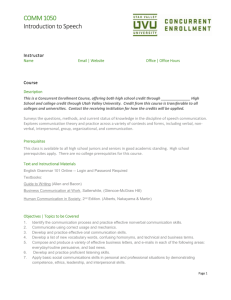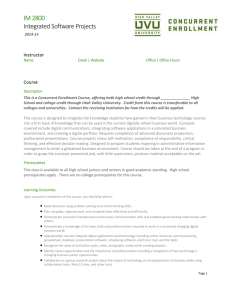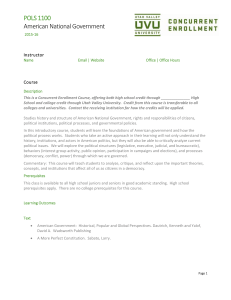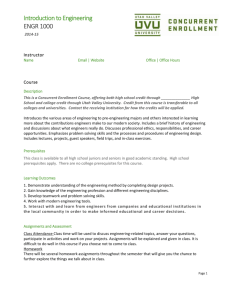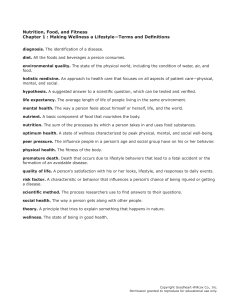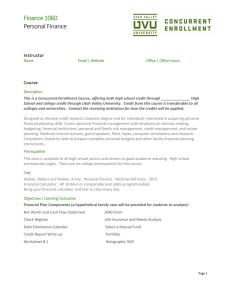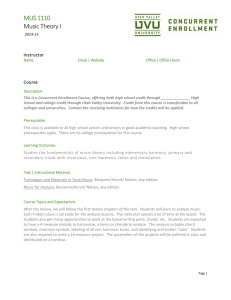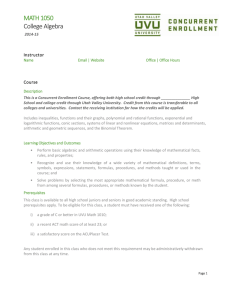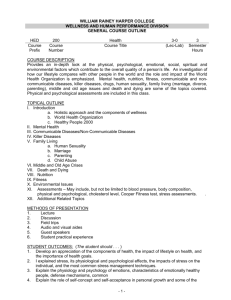HLTH 1100 Personal Health & Wellness
advertisement
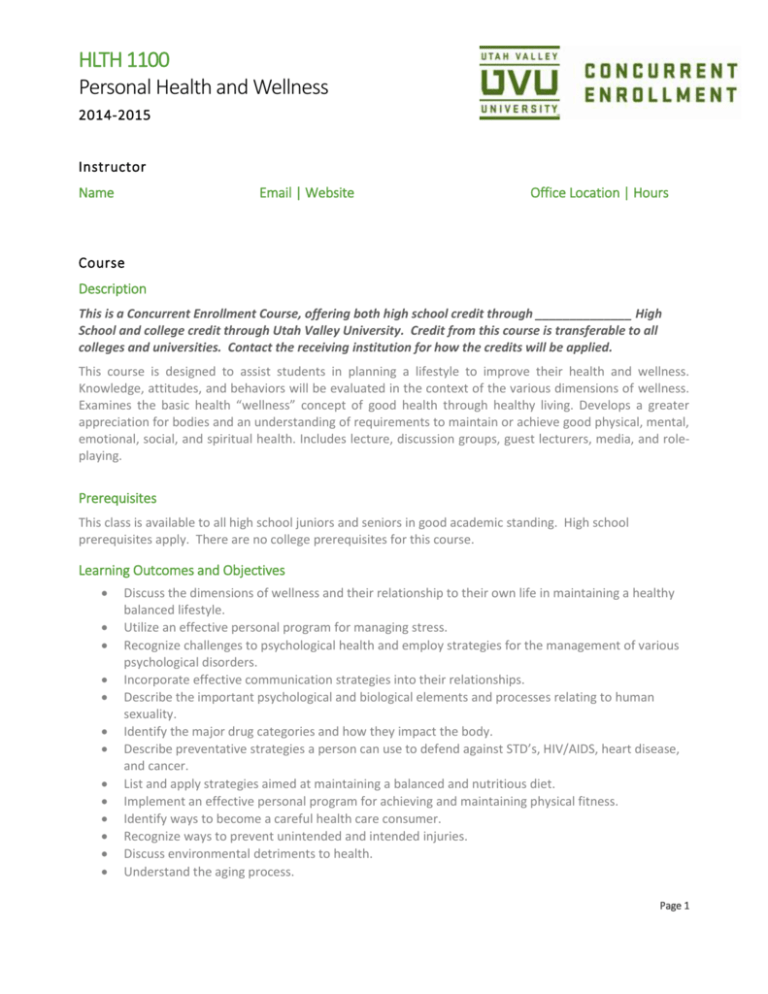
HLTH 1100 Personal Health and Wellness 2014-2015 Instructor Name Email | Website Office Location | Hours Course Description This is a Concurrent Enrollment Course, offering both high school credit through ______________ High School and college credit through Utah Valley University. Credit from this course is transferable to all colleges and universities. Contact the receiving institution for how the credits will be applied. This course is designed to assist students in planning a lifestyle to improve their health and wellness. Knowledge, attitudes, and behaviors will be evaluated in the context of the various dimensions of wellness. Examines the basic health “wellness” concept of good health through healthy living. Develops a greater appreciation for bodies and an understanding of requirements to maintain or achieve good physical, mental, emotional, social, and spiritual health. Includes lecture, discussion groups, guest lecturers, media, and roleplaying. Prerequisites This class is available to all high school juniors and seniors in good academic standing. High school prerequisites apply. There are no college prerequisites for this course. Learning Outcomes and Objectives Discuss the dimensions of wellness and their relationship to their own life in maintaining a healthy balanced lifestyle. Utilize an effective personal program for managing stress. Recognize challenges to psychological health and employ strategies for the management of various psychological disorders. Incorporate effective communication strategies into their relationships. Describe the important psychological and biological elements and processes relating to human sexuality. Identify the major drug categories and how they impact the body. Describe preventative strategies a person can use to defend against STD’s, HIV/AIDS, heart disease, and cancer. List and apply strategies aimed at maintaining a balanced and nutritious diet. Implement an effective personal program for achieving and maintaining physical fitness. Identify ways to become a careful health care consumer. Recognize ways to prevent unintended and intended injuries. Discuss environmental detriments to health. Understand the aging process. Page 1 Text Donatelle, R.J. (201). Health: The Basics 10th edition. Or a recent edition of this book Department Attendance and Participation Regular attendance is necessary for the successful completion of this course. Assessment Exams: Two exams covering course material will be given during the semester Exam items will focus on both material from the text and ideas discussed in class. Format will include multiple-choice and true/false. Lifestyle Analysis: Each student will identify environmental and lifestyle factors currently impacting his/her health either by improving or damaging his/her health. Environmental factors might include air and water quality, temperature, availability of resources, etc. Personal, lifestyle factors should include individual behaviors either improving his/her health or contributing to unhealthy outcomes. An address where you can find the self-assessment tools will be provided in class. Family Health History: Each student will investigate his/her family health history. Communication with mom and/or dad should be made in order to determine chronic, genetically-influenced occurring within the family (i.e. heart disease, certain cancers, diabetes, etc.). The information can be presented in a narrative form (i.e. “my father has suffered from diabetes, alcoholism, and depression for many years,” “my mother has…”) or it can be presented in a family health history tree diagram as presented below. The assignment must also include a section discussing what was learned from the experience and how this knowledge affects the student (i.e. behavior changes, early screening tests, etc.) The student should feel comfortable in what he/she is sharing with the instructor and should know the information will be kept in strict confidence. Grading will be based on the following: Two Exams-Midterm and Final-75%; Self-Assessment Exercises-25% 25 Extra Credit (optional) Page 2 Grading Scale A = 100-95 B - = 83-80 D+ = 69-67 A - = 94-90 C+ = 79-77 D = 66-64 B+ = 89-87 C = 76-74 D - = 63-60 B = 86-84 C - = 73-70 F = 59-0 Grades and Credit You will receive the same grade for your high school course as you receive for your college course. Your grade for this class will become part of your permanent college transcript and will affect your GPA. A low grade in this course can affect college acceptance and scholarship eligibility. University Academic Integrity Utah Valley University expects all students to maintain integrity and high standards of individual honesty in academic work, to obey the law, and to show respect for others. Students of this class are expected to support an environment of academic integrity, have the right to such an environment, and should avoid all aspects of academic dishonesty. Examples of academic dishonesty include plagiarizing, faking of data, sharing information during an exam, discussing an exam with another student who has not taken the exam, consulting reference material during an exam, submitting a written assignment which was authored by someone other than you, and/or cheating in any form. Violators of this policy will be subject to disciplinary action. Cheating will not be tolerated. It will result in a FAILING grade for the course. In keeping with UVU policy, evidence of academic dishonesty may result in a failing grade in the course and disciplinary review by the college. Additional information on this topic is published in the student handbook and is available on the UVU website. Students with Disabilities If you have any disability, which may impair your ability to successfully, complete this course, please contact the Accessibility Services office, 863-8747, BU 146. Academic accommodations are granted for all students who have qualified documented disabilities. All services are coordinated with the Accessibility Services office. Dropping the Class _________ is the last day to drop the course without it showing on your transcript. _________ is the last day to withdraw from the class. If you drop the high school class, you must also withdraw from the UVU class to avoid receiving an E or UW (unofficial withdrawal). Page 3
